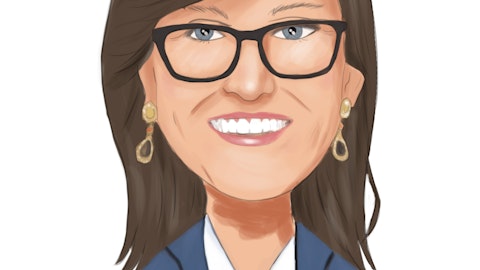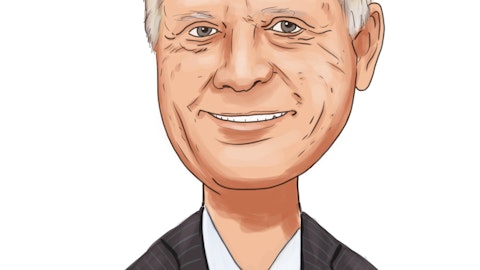Phreesia, Inc. (NYSE:PHR) Q4 2023 Earnings Call Transcript March 22, 2023
Operator: Good evening, ladies and gentlemen, and welcome to the Phreesia Fiscal Fourth Quarter 2023 Earnings Conference Call. At this time all participants are in a listen-only mode. We will provide instructions for the question-and-answer session to follow. First, I would like to introduce Balaji Gandhi, Senior Vice President, Investor Relations for Phreesia. Mr. Gandhi, you may begin.
Balaji Gandhi: Thank you, operator. Good evening, and welcome to Phreesia’s earnings conference call for the fiscal fourth quarter of 2023, which ended on January 31, 2023. Joining me on today’s call is Chaim Indig, our Chief Executive Officer. A complete discussion of our results can be found in our earnings press release and in our related Form 8-K submission to the SEC, including our quarterly stakeholder letter, both issued after the markets closed today. These documents are available on our Investor Relations website at ir.phreesia.com. As a reminder, today’s call is being recorded, and a replay will be available on our Investor Relations website at ir.phreesia.com following the conclusion of the call. During today’s call, we may make forward-looking statements, including statements regarding trends, our anticipated growth, our strategies, predictions about our industry, and the anticipated performance of our business, including our outlook regarding future financial results.
Forward-looking statements are subject to various risks, uncertainties and other factors that may cause our actual results, performance or achievements to differ materially from those described in our forward-looking statements. Such risks are described more fully in our earnings press release, our stakeholder letter and our risk factors included in our SEC filings, including in our annual report on Form 10-K that will be filed with the SEC tomorrow. The forward-looking statements made on this call will be based on our current views and expectations and speak only as of the date on which the statements are made. We undertake no obligation to update and expressly disclaim the obligation to update these forward-looking statements to reflect events or circumstances after the date of this call or to reflect new information or the occurrence of unanticipated events.
We may also refer to certain financial measures not in accordance with generally accepted accounting principles in order to provide additional information to investors. These non-GAAP measures should be considered in addition to and not as a substitute for or in isolation from our GAAP results. A reconciliation of GAAP to non-GAAP results may be found in our earnings release and stakeholder letter, which were both furnished with our Form 8-K filed after the markets closed today with the SEC and may also be found on our Investor Relations website at ir.phreesia.com. I will now turn the call over to our CEO, Chaim Indig.

Photo by Dylan Gillis on Unsplash
Chaim Indig: Thank you, Balaji, and good evening, everyone. Thank you for participating in our fourth quarter earnings call. Before we jump into some highlights of the quarter and Q&A, I’d like to talk about our CFO transition, which we also announced in an 8-K filed after the markets closed. Balaji Gandhi will take over as our CFO this Friday, March 24. Many of you on the call know Balaji. He’s been a part of our executive team over our entire existence as a public company. He’s become a trusted peer to our executive team and Board of Directors in terms of planning and communicating Phreesia’s strategy, brings over two decades of knowledge and background in the health care space as an investment analyst and industry executive, including the past four years with Phreesia.
He has been invaluable to us in his previous role, and we are excited about the contributions he will make as CFO. Let me also thank our outgoing CFO, Randy Rasmussen. When Randy joined us in 2019, we had a small finance organization for our company with about 500 employees and $150 million of revenue. Randy helped build a great finance organization and implemented processes, systems and controls that we believe are important for a public company to be able to deliver durable and profitable growth over time. Now moving on to our results. Our stakeholder letter and earnings release came out about an hour ago but let me start the call by sharing a few key highlights of the material we released. Revenue in the third quarter was $77 million, up 32% year-over-year.
That’s our eighth consecutive quarter of over 30% year-over-year revenue growth. Thank you and congratulations to the entire Phreesia team, a fantastic job. In the quarter, our average number of health care services clients was 3,140, up 36% year-over-year. We added 158 average health care services clients from the third quarter to the fourth quarter. Health care services revenue, which is the combination of subscription and related services, and payment processing revenue was up 31% year-over-year in the fourth quarter. Total revenue per average health care services client, a new key metric beginning this quarter, was $24,390, down 3% year-over-year and 1% sequentially. The decline was primarily driven by our average health care services client growth outpacing revenue growth in subscription and related services and payment processing.
Subscription-related services revenue grew 35% year-over-year. Payment processing revenue grew 23% year-over-year and network solutions revenue was up 36% year-over-year. Moving on to our outlook for fiscal ’24, which ends January 31, 2024. We expect revenue for fiscal 2024 to be in a range of $353 million to $356 million, implying growth of 26% to 27% over our just reported fiscal 2023 revenue. We expect adjusted EBITDA to be in a range of negative $65 million to negative $60 million showing continued improvement on our path to profitability. We expect to see a sequential quarter increase in average health care services clients in the first quarter of fiscal 2024 that is similar with the 158 sequential increase we saw in the fourth quarter of fiscal 2023.
We also expect subscription and related services revenue per average health care services client to remain roughly in line with our fiscal fourth quarter results. We continue to see solid operating leverage and we expect to return to adjusted EBITDA profitability in fiscal year 2025 while reaching $500 million in annualized revenue during fiscal 2025. We remain comfortable with our ability to finance our fiscal year 2025 targets with our cash position. We believe our capital allocation strategy sets us up to deliver on our financial targets for fiscal 2025 and beyond. Operator, we think we can now open it up to Q&A.
Operator: Thank you. . We’ll hear first today from Anne Samuel with JPMorgan.
Anne Samuel: Ho. Congrats on a great quarter and congratulations, Balaji, on the very exciting news. Maybe my first question is on network solutions. You saw really, really strong growth in this segment once again. And I was wondering if, perhaps, you could discuss a little bit about how we should be thinking about underlying market growth in that segment and how you expect to grow relative to that. And then, you’ve seen some relative insulation versus some of your peers in this space that have seen some pressure from pharma advertising budget. So just wondering if you could speak to why maybe you’re more insulated versus others.
See also 12 Best Cybersecurity Stocks to Buy Now and 10 Best Blue Chip Stocks to Buy.
Q&A Session
Follow Phreesia Inc. (NYSE:PHR)
Follow Phreesia Inc. (NYSE:PHR)
Receive real-time insider trading and news alerts
Chaim Indig: Hey, Annie, I’ll let Balaji say thank you first, I guess.
Balaji Gandhi: Thanks, Annie.
Chaim Indig: So I guess your question, if I heard it correctly, is why are we doing well on network solutions?
Anne Samuel: Why relative versus others, and then also just kind of thinking long-term, how do we think about maybe what the underlying market growth rate is for that segment.
Chaim Indig: Look, I think the tone has shifted in the market. And so first and foremost, I think, from what we see, our clients are really focused on ROI, tried-and-tested tactics and platforms that could deliver like clear, like scaled ROI that meaningfully help patients understand their therapies and understand different treatment pathways and understand different things that are important to their care. And so first and foremost, that’s probably what we’ve seen in sort of the market. And we do those things, right? The other reason is, frankly, we got a great team, and they’re doing really well. And I think the reason we’re doing really well is because of the team and how they’ve been out in front working with clients and making sure they understand the value. Frankly, on behalf of everyone, I just want to give them my thank you. Everyone on life sciences and our payer teams have just done a great job. And so thank you to all of them. I know they’re listening.
Anne Samuel: That’s helpful color. And then in your letter, you spoke about completing your first enrollment period in the payer space. And since you’re kind of new to the payer space, and we haven’t seen as much there, I was hoping you could maybe talk a little bit about how MemberConnect helped with that and what it looked like for you.
Chaim Indig: It looked okay. And it’s still early days. I don’t think we’re prepared to talk much about it. I think we’re still learning. But it did a little bit better than we thought it would. And I was proud of the team. It was hard. We had to do things a little bit. I don’t think we’ve automated a lot of our solutions yet, but I think we’re working pretty hard on building a lot of products around it. And I think everyone was pretty excited about our first year doing it.
Balaji Gandhi: And Annie, I’d just add two things. One, it is still early, and we’re still learning. And two, you’ll remember we raised the guidance into the fourth quarter knowing what we knew about the enrollment period back then in December. So some of that opportunity is already in the results.
Chaim Indig: Everyone at Phreesia is pretty proud of the work that they’re doing. So it’s fine.
Anne Samuel: Great.
Operator: We’ll hear next today from Ryan Daniels with William Blair.
Jared Haase: Hey, good evening. Thanks for taking the question. This is Jared on for Ryan. I’ll first echo the congrats to Balaji on the transition here. And then I did actually want to ask a follow-up on the point around ROI related to the life sciences offering. So in the letter, it looks like one of the drivers of upside that you mentioned was taking programs live earlier than expected. I’m sort of curious, was that just a one-off trend this cycle, or do you think that that’s kind of due to clients realizing that’s ROI from the platform and kind of getting their budgets in order for the year so that they can kind of be on channel, so to speak, for more time each year?




